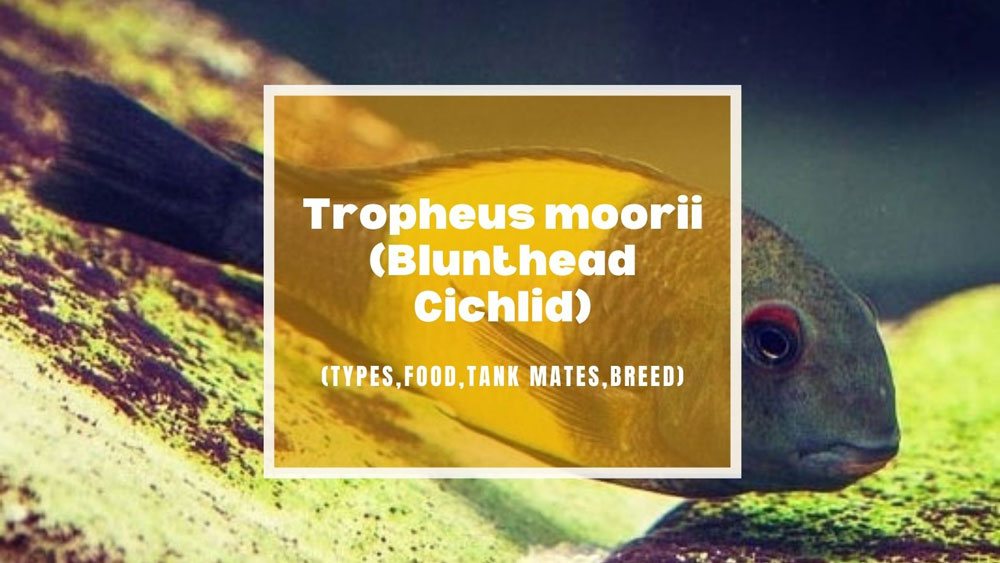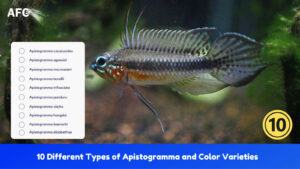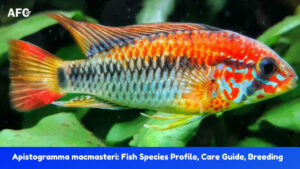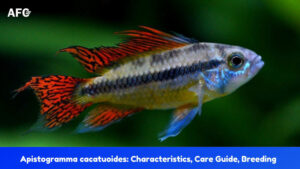Lake Tanganyika fish is known for its variety; Tropheus moorii (Blunthead Cichlid) is the king of color morphs, which has more than 50 geographic variations, each with unique coloration and pattern depending on the area where it’s observed.
Because of their stunning colors and interesting behaviors, this species is sought after among African Cichlid enthusiasts. Unfortunately, Tropheus moorii care can be tricky, and it’s definitely an “expert-only” species.
The main reason for this is their aggression toward conspecifics and the tendency to be susceptible to “bloat” if stressed. You must be very careful when setting up a Tropheus moorii aquarium and have diligent attention to detail to ensure the fish stay healthy and thrive.
But, if you’re up for the challenge, Tropheus moorii are a stunning addition to any Lake Tanganyika Cichlid setup. And that’s why we’ve put together this Tropheus moorii care guide to help you get started!
Species Summary
The striking Tropheus moorii (blunthead cichlid) is endemic to Lake Tanganyika. They tend to be found over rocky shallows at depths of 6 to 10 feet, where they are found in large groups and primarily feed on filamentous algae.
Unlike Tanganyika Sand sifters, such as Calvus Cichlid (A. calvus) and Sardine Cichlid (C. leptosoma), these fish prefer precipitous rocks and continuous rubble instead of soft sandy areas.
Being the first recognized species of the Tropheus genus, T. moorii was described by Boulenger in 1898 and is currently listed as Least Concern (LC) on the IUCN Red list due to its abundant varieties and broad distributions. While its population has declined in recent years due to habitat loss and the impacts of the aquarium trade.
Owning its distinctive larger head in proportion to the body and small body size, T. moorii has many common names, including Blunthead Cichlid, Blunt-Headed Cichlid, Brabant Cichlid, Moorii, and Dwarf Tanganyikan Cichlid. More than that, many names are representative of their vibrant coloration, including Tanzania Red Rainbow, Yellow Rainbow, Blue Rainbow, Sunspot, Orangefleck, and more.
No matter what variants or species you bring home, all Tropheus species are territorial and aggressive. Both males and females will relentlessly chase conspecifics and congeners, even in large tanks.
| Scientific Name: | Tropheus moorii |
| Common Name: | Blunthead Cichlid, Blunt-Headed Cichlid, Brabant Cichlid, Moorii, and Dwarf Tanganyikan Cichlid |
| Care Level: | Advanced |
| IUCN Red List: | LC |
| Origin: | Lake Tanganyika |
| Lifespan: | 5– 8 years |
| Max Size: | 5 inches (12 cm) |
| Temperature: | 73 – 81°F (23 – 27°C) |
| PH: | 8.0 to 9.5 |
| Water hardness: | 8 to 22 |
| Diet: | Herbivores |
| Minimum Tank Size: | 75 gallons (48″ x 18″ x 21″) |
| Temperament: | Aggressive |
Appearance
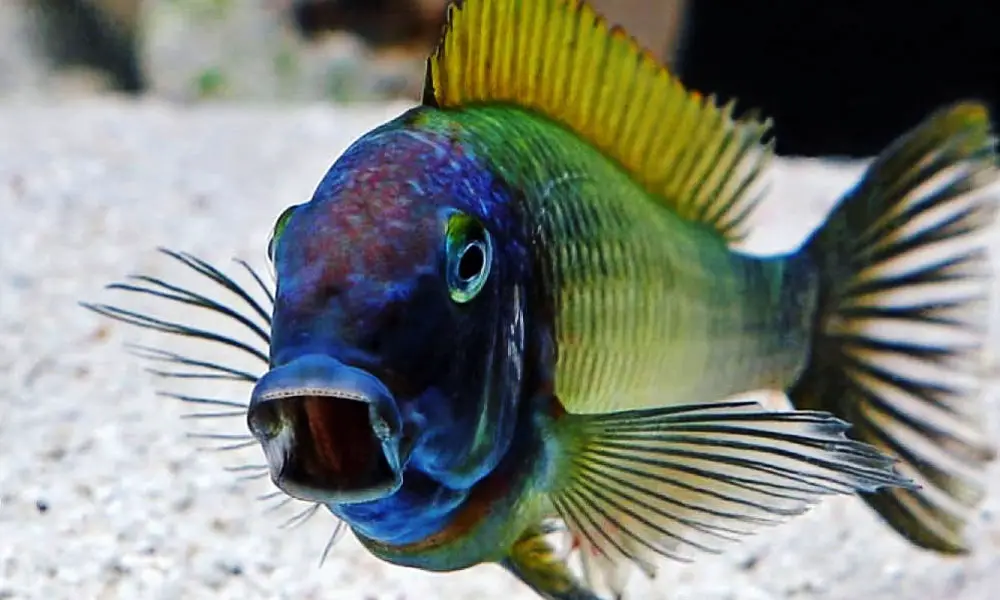
It’s not hard to see why Tropheus moorii is so sought-after. Their unique appearance helps them stand out among other cichlids, with their large head and small body being the most distinctive features.
Their bodies are relatively stocky. Caudally, the body narrows further and forms the fan-shaped caudal fin. Like many other Lake Tanganyika species that feed on epiphyte, Blunthead cichlids have specialized pharyngeal teeth in their underslung mouth used for scraping algae off rocks’ surfaces.
The top edge of their dorsal, anal, pectoral, and pelvic fins are armed with spiny rays to help ward off predators and conspecifics. But the bulk of these fins is soft, which are used for balance and stability.
An interesting note on Tropheus moorii is, like any other cichlids, they develop a single external nostril opening on each side of the forehead, while other freshwater fish are paired with double structures.
Tropheus moorii Types
T. moorii takes the cake when it comes to color morphs and variants. In fact, more than 50 color morphs and over 120 variants have been identified so far!
Each Tropheus moorii color morph is found in a specific geographic location and has unique coloration and patterning.
Here are many well-known color varieties.
Tropheus moorii “Mpulungu”
Tropheus moorii “Mpulungu,” often referred to as Pineapple Tropheus and Sunset Moorii, is found in Mpulungu – the southern tip of Lake Tanganyika. As their name suggests, Tropheus moorii “Mpulungu” boasts bright yellow-orange spots speckled across their darker bodies and fins.
Tropheus moorii “Kasanga”
Known as the Tropheus Moorii Red Rainbow, this beautiful variety is endemic to Kasanga, Tanzania. T. moorii “Kasanga” is one of the most popular Tropheus varieties due to its gorgeous red coloration of the rainbow.
Tropheus moorii “Mboko”
Offering a more unique color pattern, Tropheus moorii “Mboko” hails from Mboko Island on the shores of Lake Tanganyika. Their common name, Tropheus Moorii Yellow Banded, originates from the distinct broad, bright yellow vertical band running down their black body.
Tropheus moorii “Moliro”
Tropheus moorii “Moliro” or Red-tail Moorii is endemic to the Moliro, Congo – beside Lake Tanganyika on the border with Zambia. Of course, these fish are well known for their red tails, which primarily gives them their common name.
Tropheus moorii “Bemba” (Pemba)
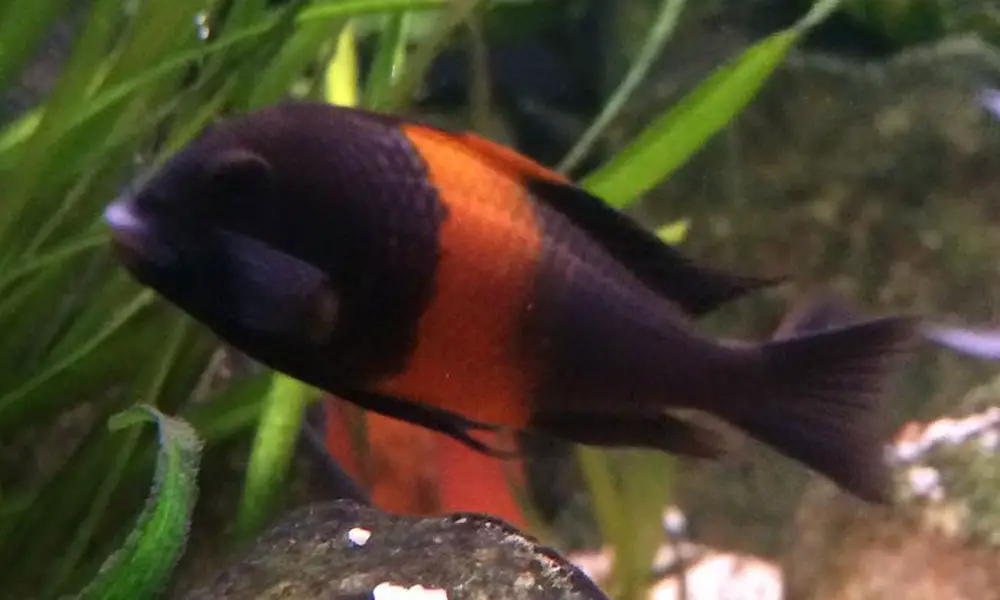
Tropheus moorii “Bemba” (common name: Tropheus Bemba Orange Flame Cichlid) is probably my favorite. It comes from Bemba (Pemba) village, which was located in Cape Munene. Unfortunately, this village doesn’t exist anymore.
As its name suggests, T. moorii “Bemba” has an intense orange flame-like vertical bar running down their black bodies, making for a stunning contrast.
Tropheus moorii “Bulu Point”
Tropheus moorii “Bulu Point” is a color morph endemic to Bulu Point Island. It’s also called Cherry Spot Tropheus among hobbyists due to its large cherry red speckles on a black body.
Tropheus moorii “Chimba”
Tropheus moorii “Chimba” is only found in Chimba Island, a small region on the southwestern corner of the lake. This is a stunning fish that shows brilliant red coloration going through stages of its life, which really pops against with black aquarium background.
Tropheus moorii “Chipimbi”
Another vibrant moorii comes from Chipimbi, western Zambia. It’s characterized by a neon red line that starts from the base of the tail fin and goes all the way up to the middle of its body. Interested to know that this fish is one of the first red morphs imported.
Tropheus moorii “Chaitika”
This Tropheus comes from Chaitika, Zambia. The name of the Blue Rainbow does a great job of describing its vivid blue coloration that’s accentuated by a horizontal yellow stripe. And much like Tropheus moorii “Kasanga,” these fish are also quite popular in the aquarium trade.
Tropheus moorii Size & Growth Rate
The average Tropheus moorii size is around 5 inches (12.7 cm) long in captivity.
No matter what Tropheus moorii color morphs you choose, you can expect a rapid growth rate during their first 9 to 12 months – they can reach maturity at 3 to 4 inches ( 7.5 – 10 cm) and start to show their adult coloration.
As always, these figures vary depending on the quality of care they receive. If you want your mooriis to reach their full potential size and coloration, you’ll need to devote yourself to providing them with the best possible environment.
Blunthead Cichlid Lifespan
The Tropheus moorii lifespan is around 5– 8 years, but some have been known to live up to 10 years in captivity.
Their lifespan can be influenced by the typical factors that affect any fish. Poor water quality and high stress, for example, can lead to a shortened Tropheus moorii lifespan.
Care & Tank Set up
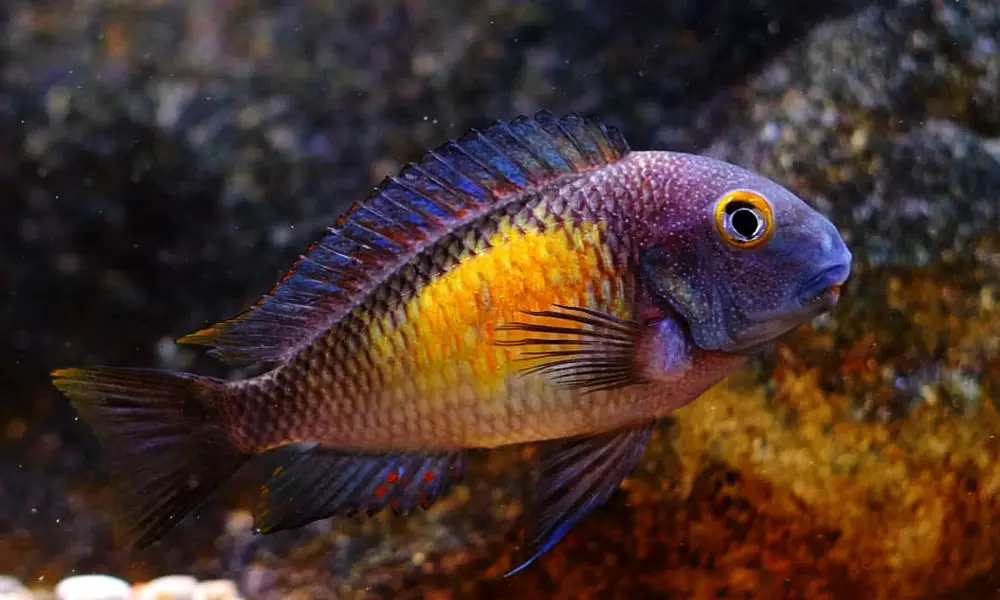
These cichlids are very aggressive and territorial and are known to attack and kill tank mates – even other Tropheus moorii.
So, if you’re considering keeping Tropheus moorii in your aquarium, be prepared for a bit of a challenge. Not to mention, these fish are susceptible to the disease of the digestive disorders such as “bloat.”
This makes them one of the difficult cichlids to keep, and they’re really only recommended for experienced aquarium hobbyists.
Tropheus moorii Tank Size
The minimum size for a group of at least 15 individuals is 75 gallons (48″ x 18″ x 21″). However, that’s the bare minimum. If you have the space, I recommend going up to 125 gallons (72″ x 18″ x 21″).
This number will obviously increase depending on the number of other fish you plan on keeping in the tank.
Water Parameters
When it comes to Tropheus moorii tank conditions, you’ll need to recreate their natural habitat as closely as possible. These cichlids come from the shallower regions of Lake Tanganyika, so they need hard alkaline water.
Considering that the water conditions in Lake Tanganyika are pretty stable and there are no high ammonia/nitrite/nitrate levels, you’ll want to replicate those same water parameters in your Tropheus moorii tank.
Here are the ideal Tropheus moorii water parameters:
- Water temperature: 73 – 81°F (23 – 27°C)
- pH levels: 8.0 to 9.5
- Water hardness: 8 to 22
- Ammonia: 0ppm
- Nitrite: 0ppm
- Nitrate: <20ppm
Like any other Lake Tanganyika Cichlids, Tropheus moorii don’t tolerate rapid water changes unless the new water parameters are very close to what they’re already used to. To avoid any water quality issues, I recommend doing an immediate water change of about 20-25% weekly.
Also, oxygenated water is a must. Poor water quality and low oxygenation will stress your fish and make them susceptible to African “bloat”. You can achieve this by using an air stone or powerhead.
Substrate & Decor
A well-designed tank is crucial for any fish care. Tropheus mooriis spend most of their time roaming among rocks and interlocking rubble, so spending time getting things just right will go a long way.
Use a sandy substrate and arrange the rocks in a way that provides plenty of hiding spots and territories without putting any fish in danger. The male Tropheus mooriis are known to be pretty aggressive, so you must ensure everyone has a place to escape.
Diet & Nutrition
Tropheus species are known herbivores, and Tropheus moorii is no different.
In the wild, they mainly eat algae scraped from the rocks but also consume worms, small crustaceans, and insects.
In captivity, their diet should consist of vegetables. You can give them quality spirulina-based flakes and pellets as the base of their diet and supplement them with fresh vegetables, such as spinach, peas, and romaine. Also, feen them frozen Mysis and krill to ensure they get the necessary variety and nutrition.
Be sure to check the ingredients list on any food you give your Tropheus moorii to make sure it’s suitable for herbivores- it doesn’t contain much animal protein.
I’ve heard from aquarists who suggested never giving Tropheus moorii protein food to avoid health problems. But, I have feed NLS pellets (1mm) to my Tropheus without any issues.
- New Life Spectrum is made from quality natural ingredients
- Extreme Color enhancement and vitality in your fish
- Made in the USA
Behavior & Temperament
If you’ve ever done a search for Tropheus moorii tank mates, you’ve probably come across a lot of discussion about their aggressive nature.
Many aquarists seem to be afraid of Tropheus because they can be pretty aggressive. In my opinion, this is usually due to one of four factors:
- Your tank set up is incorrectly
- The number of fish is too small
- The number of fish is too small in a particular group
- The sizes of fish are mismatched
Let’s take a closer look at each of these factors.
If the tank setup is incorrect, any fish will be more likely to be aggressive. This is simply because they will feel cramped and stressed in an unsuitable environment. Make sure your tank is at least 75 gallons and has plenty of hiding places.
Too few Tropheus can also lead to aggression. Tropheus are not natural schooling fish but need to be kept in groups of at least 15-20 fish. If there are too few Tropheus in the tank, they may become aggressive towards each other. All Tropheus species will develop a natural pecking order or hierarchy, and most deaths come from fighting within their own species. They rarely do attack other species.
If you house T. moorii with other Tropheus species, they also need to be grouped correctly. Although they usually go along and ignore each other, some species or variations can be very territorial than others. So, when mixing Tropheus species, try to make things equal.
There is always a risk to housing Tropheus in different sizes together. If you have a T. moorii much larger than the others, it may become aggressive and bully the smaller fish.
Tropheus moorii Tank Mates
Since Tropheus moorii are super aggressive and active swimmers, they do best in large groups of at least 15 or more(with one or two males) in specie only tanks.
As we mentioned above, they are relatively peaceful towards other species, so you can keep them with many peaceful species but have a similar diet requirement.
Of course, you can keep T. moorii with the other five Tropheus species as long as you have a large aquarium, but never mix different variants within the same tank. Compared with mixing different Tropheus species, keeping two or more color morphs together is more likely to cause interbreeding. Well, there is no guarantee.
Here are some possible Tropheus moorii Tank Mates:
- Marlieri Cichlid (Julidochromis Marlieri)
- Brown Julie (Julidochromis dickfeldi )
- Convict Julie (Julidochromis regani)
- Golden Julie (Julidochromis ornatus)
- Striped Goby Cichlid (Eretmodus cyanostictus)
- Spotfin Goby Cichlid (Tanganicodus irsacae)
- Cyprichromis leptosoma (Sardine Cichlid)
- Synodontis spp. (Cuckoo Catfish | Dwarf Petricola | Lace catfish)
- Duboisi Cichlid (Tropheus duboisi)
Blunthead Cichlid Breeding
The Blunthead Cichlid is a maternal mouthbrooder. It has been bred in home aquariums for years.
Sexual Differences
Blunthead Cichlids are sexually monomorphic, and it’s hard to distinguish the males from the females.
There are some subtle differences between the sexes, but they are not reliable. The males have a more prominent, lighter upper lip owning to their lip-locking behavior. Furthermore, males grow faster and develop their brighter adult coloration sooner than females. Speaking of body shape, adult males have a relatively deeper body, whereas females tend to be more slender.
The only reliable way to determine the sex of your Tropheus moorii is by venting. I will try to get a picture for you to have a look at. But, for now, there is a very great article from Gary Kratochvil, that shows how to do it.
Breeding Practices
Breeding Tropheus moorii is not tricky, but it does require some specific conditions. This fish is serial monogamy, which means that a single male will mate with a female to establish a temporary monogamous pair bond and spawn.
Tropheus moorii are best bred in a single-species tank, which is another advantage of keeping a Tropheus-only aquarium.
Mixing two or more groups of Tropheus species often results in a dominant male from one of the groups, which means this group will likely breed more frequently. So, don’t expect they can breed with the same frequency. In most cases, Tropheus moorii will end up at the bottom of the breeding since they are a little more challenging to reproduce.
To increase your chances of successful breeding, get a group of 15 to 25 juveniles in a 125 gallons tank, and allow them to grow up together. This will allow them to establish their own hierarchy within the group and, hopefully, avoid aggression.
When they reach sexual maturity at around 1 year old, you should start to see some color changes in the males as they become more intense and brighter. If you have more than one male, watch closely to see if any aggression starts to appear. If so, you will need to remove the dominant or subdominant males from the tank until you have the desired sex ratio (M: F = 1:10).
T. moorii spawn in open water. The female lays only a few eggs (5 to 17). Once laid, the female will quickly collect them in her mouth and incubate them until they hatch, which takes about 21 to 28 days.
The fry are only 1/2 inches (0.57 cm) but will quickly increase their growth rate if you provide them with brine shrimp nauplii.
Conclusion
Tropheus moorii is a beautiful and fascinating fish that can make a great addition to your aquarium. Unfortunately, these fish are not easy to care for due to their aggressive nature. They need to be kept in a large tank with plenty of hiding places and a good filtration system.
Depending on the variety, many variations are accidentally available in the fish store at a relatively costly price. Adult fish usually cost more than fry. Additionally, many hybrids are sold on the market, so be sure to purchase fish from a reliable breeder.
If you have any questions or would like to share your experiences with Tropheus moorii, please leave a comment below.
Happy Tropheus keeping!
